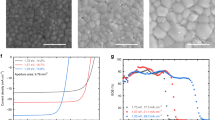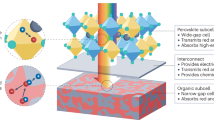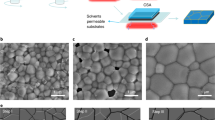Abstract
Multi-junction all-perovskite tandem solar cells are a promising choice for next-generation solar cells with high efficiency and low fabrication cost. However, the lack of high-quality low-bandgap perovskite absorber layers seriously hampers the development of efficient and stable two-terminal monolithic all-perovskite tandem solar cells. Here, we report a bulk-passivation strategy via incorporation of chlorine, to enlarge grains and reduce electronic disorder in mixed tin–lead low-bandgap (~1.25 eV) perovskite absorber layers. This enables the fabrication of efficient low-bandgap perovskite solar cells using thick absorber layers (~750 nm), which is a requisite for efficient tandem solar cells. Such improvement enables the fabrication of two-terminal all-perovskite tandem solar cells with a champion power conversion efficiency of 21% and steady-state efficiency of 20.7%. The efficiency is retained to 85% of its initial performance after 80 h of operation under continuous illumination.
This is a preview of subscription content, access via your institution
Access options
Access Nature and 54 other Nature Portfolio journals
Get Nature+, our best-value online-access subscription
$29.99 / 30 days
cancel any time
Subscribe to this journal
Receive 12 digital issues and online access to articles
$119.00 per year
only $9.92 per issue
Buy this article
- Purchase on Springer Link
- Instant access to full article PDF
Prices may be subject to local taxes which are calculated during checkout



Similar content being viewed by others
Data availability
The data that support the findings of this study are available from the corresponding authors upon reasonable request.
References
Kojima, A., Teshima, K., Shirai, Y. & Miyasaka, T. Organometal halide perovskites as visible-light sensitizers for photovoltaic cells. J. Am. Chem. Soc. 131, 6050–6051 (2009).
Shin, S. S. et al. Colloidally prepared La-doped BaSnO3 electrodes for efficient, photostable perovskite solar cells. Science 356, 167–171 (2017).
Best Research-Cell Efficiencies (NREL, 2018); https://www.nrel.gov/pv/assets/pdfs/pv-efficiencies-07-17-2018.pdf.
Malinkiewicz, O. et al. Perovskite solar cells employing organic charge-transport layers. Nat. Photon. 8, 128–132 (2014).
McMeekin, D. P. et al. A mixed-cation lead mixed-halide perovskite absorber for tandem solar cells. Science 351, 151–155 (2016).
Stoumpos, C. C., Malliakas, C. D. & Kanatzidis, M. G. Semiconducting tin and lead iodide perovskites with organic cations: phase transitions, high mobilities, and near-infrared photoluminescent properties. Inorg. Chem. 52, 9019–9038 (2013).
Hao, F., Stoumpos, C. C., Chang, R. P. H. & Kanatzidis, M. G. Anomalous band gap behavior in mixed Sn and Pb perovskites enables broadening of absorption spectrum in solar cells. J. Am. Chem. Soc. 136, 8094–8099 (2014).
Eperon, G. E. et al. Perovskite–perovskite tandem photovoltaics with optimized bandgaps. Science 354, 861–865 (2016).
Anaya, M., Lozano, G., Calvo, M. E. & Míguez, H. ABX3 perovskites for tandem solar cells. Joule 1, 769–793 (2017).
Werner, J. et al. Efficient near-infrared-transparent perovskite solar cells enabling direct comparison of 4-terminal and monolithic perovskite/silicon tandem cells. ACS Energy Lett. 1, 474–480 (2016).
Fu, F. et al. Low-temperature-processed efficient semi-transparent planar perovskite solar cells for bifacial and tandem applications. Nat. Commun. 6, 8932 (2015).
Forgács, D. et al. Efficient monolithic perovskite/perovskite tandem solar cells. Adv. Energy Mater. 7, 1602121 (2017).
Rajagopal, A. et al. Highly efficient perovskite–perovskite tandem solar cells reaching 80% of the theoretical limit in photovoltage. Adv. Mater. 29, 1702140 (2017).
Eperon, G. E., Hörantner, M. T. & Snaith, H. J. Metal halide perovskite tandem and multiple-junction photovoltaics. Nat. Rev. Chem. 1, 0095 (2017).
Song, Z. et al. A technoeconomic analysis of perovskite solar module manufacturing with low-cost materials and techniques. Energy Environ. Sci. 10, 1297–1305 (2017).
Zhao, D. et al. Low-bandgap mixed tin–lead iodide perovskite absorbers with long carrier lifetimes for all-perovskite tandem solar cells. Nat. Energy 2, 17018 (2017).
Bu, T. et al. A novel quadruple-cation absorber for universal hysteresis elimination for high efficiency and stable perovskite solar cells. Energy Environ. Sci. 10, 2509–2515 (2017).
Huang, J., Yuan, Y., Shao, Y. & Yan, Y. Understanding the physical properties of hybrid perovskites for photovoltaic applications. Nat. Rev. Mater. 2, 17042 (2017).
Tan, H. et al. Efficient and stable solution-processed planar perovskite solar cells via contact passivation. Science 355, 722–726 (2017).
Shao, Y., Xiao, Z., Bi, C., Yuan, Y. & Huang, J. Origin and elimination of photocurrent hysteresis by fullerene passivation in CH3NH3PbI3 planar heterojunction solar cells. Nat. Commun. 5, 5784 (2014).
Shao, Y., Yuan, Y. & Huang, J. Correlation of energy disorder and open-circuit voltage in hybrid perovskite solar cells. Nat. Energy 1, 15001 (2016).
Zheng, X. et al. Defect passivation in hybrid perovskite solar cells using quaternary ammonium halide anions and cations. Nat. Energy 2, 17102 (2017).
Xiao, Z. et al. Solvent annealing of perovskite-induced crystal growth for photovoltaic-device efficiency enhancement. Adv. Mater. 26, 6503–6509 (2014).
Zhao, D. et al. High-efficiency solution-processed planar perovskite solar cells with a polymer hole transport layer. Adv. Energy Mater. 5, 1401855 (2015).
Wu, Y. et al. Perovskite solar cells with 18.21% efficiency and area over 1 cm2 fabricated by heterojunction engineering. Nat. Energy 1, 16148 (2016).
Liao, W. et al. Fabrication of efficient low-bandgap perovskite solar cells by combining formamidinium tin iodide with methylammonium lead iodide. J. Am. Chem. Soc. 138, 12360–12363 (2016).
Zhao, Y. & Zhu, K. CH3NH3Cl-assisted one-step solution growth of CH3NH3Pb3: structure, charge carrier dynamics, and photovoltaic properties of perovskite solar cells. J. Phys. Chem. C 118, 9412–9418 (2014).
Yang, M. et al. Perovskite ink with wide processing window for scalable high-efficiency solar cells. Nat. Energy 2, 17038 (2017).
Liao, W. et al. Lead-free inverted planar formamidinium tin triiodide perovskite solar cells achieving power conversion efficiencies up to 6.22%. Adv. Mater. 28, 9333–9340 (2016).
Yang, B. et al. Enhancing ion migration in grain boundaries of hybrid organic–inorganic perovskites by chlorine. Adv. Funct. Mater. 27, 1700749 (2017).
Starr, D. E. et al. Direct observation of an inhomogeneous chlorine distribution in CH3NH3PbI3− xClx layers: surface depletion and interface enrichment. Energy Environ. Sci. 8, 1609–1615 (2015).
Sadhanala, A. et al. Preparation of single-phase films of CH3NH3Pb(I1–xBrx)3 with sharp optical band edges. J. Phys. Chem. Lett. 5, 2501–2505 (2014).
De Wolf, S. et al. Organometallic halide perovskites: sharp optical absorption edge and its relation to photovoltaic performance. J. Phys. Chem. Lett. 5, 1035–1039 (2014).
Zhao, B. et al. High open-circuit voltages in tin-rich low-bandgap perovskite-based planar heterojunction photovoltaics. Adv. Mater. 29, 1604744 (2016).
Johnson, S. R. & Tiedje, T. Temperature dependence of the Urbach edge in GaAs. J. Appl. Phys. 78, 5609–5613 (1995).
Zanatta, A. R. & Chambouleyron, I. Absorption edge, band tails, and disorder of amorphous semiconductors. Phys. Rev. B 53, 3833–3836 (1996).
Burlingame, Q. et al. Centimetre-scale electron diffusion in photoactive organic heterostructures. Nature 554, 77 (2018).
Song, Z. et al. Perovskite solar cell stability in humid air: partially reversible phase transitions in the PbI2–CH3NH3I–H2O system. Adv. Energy Mater. 6, 1600846 (2016).
Cheyns, D., Kim, M., Verreet, B. & Rand, B. P. Accurate spectral response measurements of a complementary absorbing organic tandem cell with fill factor exceeding the subcells. Appl. Phys. Lett. 104, 093302 (2014).
Yakimov, A. & Forrest, S. R. High photovoltage multiple-heterojunction organic solar cells incorporating interfacial metallic nanoclusters. Appl. Phys. Lett. 80, 1667–1669 (2002).
Che, X., Li, Y., Qu, Y. & Forrest, S. R. High fabrication yield organic tandem photovoltaics combining vacuum- and solution-processed subcells with 15% efficiency. Nat. Energy 3, 422–427 (2018).
Hadipour, A. et al. Solution-processed organic tandem solar cells. Adv. Funct. Mater. 16, 1897–1903 (2006).
Cao, J., Tao, S. X., Bobbert, P. A., Wong, C. P. & Zhao, N. Interstitial occupancy by extrinsic alkali cations in perovskites and its impact on ion migration. Adv. Mater. 30, 1707350 (2018).
Christians, J. A. et al. Tailored interfaces of unencapsulated perovskite solar cells for > 1,000 hour operational stability. Nat. Energy 3, 68–74 (2018).
Leijtens, T., Prasanna, R., Gold-Parker, A., Toney, M. F. & McGehee, M. D. Mechanism of tin oxidation and stabilization by lead substitution in tin halide perovskites. ACS Energy Lett. 2, 2159–2165 (2017).
Han, Y. et al. Degradation observations of encapsulated planar CH3NH3PbI3 perovskite solar cells at high temperatures and humidity. J. Mater. Chem. A 3, 8139–8147 (2015).
Zhao, J. et al. Is Cu a stable electrode material in hybrid perovskite solar cells for a 30-year lifetime? Energy Environ. Sci. 9, 3650–3656 (2016).
Lee, H. & Lee, C. Analysis of ion-diffusion-induced interface degradation in inverted perovskite solar cells via restoration of the Ag electrode. Adv. Energy Mater. 8, 1702197 (2018).
Labban, A. E. et al. Improved efficiency in inverted perovskite solar cells employing a novel diarylamino-substituted molecule as PEDOT:PSS replacement. Adv. Energy Mater. 6, 1502101 (2016).
Yu, Y. et al. Synergistic effects of lead thiocyanate additive and solvent annealing on the performance of wide-bandgap perovskite solar cells. ACS Energy Lett. 2, 1177–1182 (2017).
Zhao, D. et al. Four-terminal all-perovskite tandem solar cells achieving power conversion efficiencies exceeding 23%. ACS Energy Lett. 3, 305–306 (2018).
Zhao, D. et al. Annealing-free efficient vacuum-deposited planar perovskite solar cells with evaporated fullerenes as electron-selective layers. Nano Energy 19, 88–97 (2016).
Jackson, W. B., Amer, N. M., Boccara, A. C. & Fournier, D. Photothermal deflection spectroscopy and detection. Appl. Opt. 20, 1333–1344 (1981).
Lee, J., Rovira, P. I., An, I. & Collins, R. W. Rotating-compensator multichannel ellipsometry: applications for real time Stokes vector spectroscopy of thin film growth. Rev. Sci. Instrum. 69, 1800–1810 (1998).
Johs, B. et al. Overview of variable angle spectroscopic ellipsometry (VASE), part II: advanced applications. In SPIE Proc. (ed. Al-Jumaily, G. A.) CR72, 29–58 (1999).
Acknowledgements
The work at University of Toledo is financially supported by the US Department of Energy SunShot Initiative under the Next Generation Photovoltaics 3 programme (DE-FOA-0000990) for perovskite tandem device fabrication, the Office of Naval Research under contract no. N00014-17-1-2223 for device characterization, the Air Force Research Laboratory under the Space Vehicles Directorate (FA9453-11-C-0253) for wide-bandgap perovskite synthesis and the Ohio Research Scholar Program for device modelling and understanding. The work at the National Renewable Energy Laboratory is supported by the US Department of Energy SunShot Initiative under the Next Generation Photovoltaics 3 programme (DE-FOA-0000990) and under contract no. DE-AC36-08-GO28308 with the Alliance for Sustainable Energy, the Manager and Operator of the National Renewable Energy Laboratory.
Author information
Authors and Affiliations
Contributions
D.Z. and Y. Yan conceived the project. D.Z. carried out single-cell and tandem-cell fabrication and characterization. C.C. prepared wide-bandgap perovskite film and devices. C.W. fabricated and characterized the single low-bandgap device. Z.S. participated in tandem-cell fabrication and characterization and conducted transient photocurrent measurement and modelling. M.M.J., B.S. and N.J.P. conducted PDS and spectroscopic ellipsometry measurements. Y. Yu participated in wide-bandgap perovskite film and device fabrication. C.R.G. and C.L. helped with the characterization. D.Z., Z.S. and Y. Yan analysed the data and wrote the manuscript. K.Z. provided helpful discussions during the project and helped with the manuscript preparation. X.Z., G.F. and R.-G.X. helped with the manuscript preparation. All of the authors discussed the results and commented on the manuscript. Y. Yan supervised the project.
Corresponding authors
Ethics declarations
Competing interests
The authors declare no competing interests.
Additional information
Publisher’s note: Springer Nature remains neutral with regard to jurisdictional claims in published maps and institutional affiliations.
Supplementary information
Supplementary Information
Supplementary Figures 1–14, Supplementary Tables 1–3, Supplementary Methods, Supplementary References
Rights and permissions
About this article
Cite this article
Zhao, D., Chen, C., Wang, C. et al. Efficient two-terminal all-perovskite tandem solar cells enabled by high-quality low-bandgap absorber layers. Nat Energy 3, 1093–1100 (2018). https://doi.org/10.1038/s41560-018-0278-x
Received:
Accepted:
Published:
Issue Date:
DOI: https://doi.org/10.1038/s41560-018-0278-x
This article is cited by
-
Mixed tin-lead perovskites with balanced crystallization and oxidation barrier for all-perovskite tandem solar cells
Nature Communications (2024)
-
HTL-free non-toxic perovskite tandem solar device MAGeI3/FASnI3 with 25.69% efficiency: design and simulation using SCAPS
Journal of Optics (2024)
-
Highly Efficient 3D–2D Perovskite Tandem Solar Cells: A Combined Ray Tracing and Transfer Matrix-Based Simulation Study
Journal of Electronic Materials (2024)
-
Progress and outlook of Sn–Pb mixed perovskite solar cells
Nano Convergence (2023)
-
Oxidation-resistant all-perovskite tandem solar cells in substrate configuration
Nature Communications (2023)



